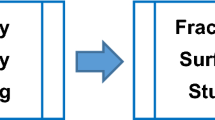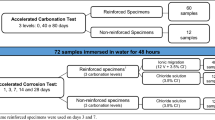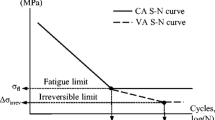Abstract
The remaining life estimation for the aged components in power plants as well as chemical plants are very important because mechanical properties of the components are degraded with in-service exposure time in high temperatures. Since it is difficult to take specimens from the operating components to evaluate mechanical properties of components, nondestructive techniques are needed to evaluate the degradation. In this study, test materials with several different degradation levels were prepared by isothermal aging heat treatment at 630°C. The DC potential drop method and destructive methods such as tensile and fracture toughness were used in order to evaluate the degradation of 1Cr-1Mo-0.25V steels. In this result, we can see that tensile strength and fracture toughness can be calculated from resistivity and it is possible to evaluate material degradation using DC potential drop method, non-destructive method.
Similar content being viewed by others
Abbreviations
- V :
-
Electrical potential
- I:
-
Current
- ρ:
-
Resistivity
- γ:
-
Distance for electrode
- t :
-
Thickness of the specimen
- t 1 :
-
Aging time at 538°C
- t 2 :
-
Aging time at 630°C
- T1 :
-
Temperature (538°C)
- T2 :
-
Temperature (630°C)
- Q :
-
Activation energy
- R :
-
Gas constant
- k :
-
Correction factor of shape specimen
- K Q :
-
Fracture toughness
References
Abdel-Latif, A.M., Corbett, J. M., Sidey, D. and Taplin, D. M. R., 1981, “Effects of Micro-sturctural Degradation on Creep Life Prediction of 2-1/4Cr-1Mo Steel,”Advanced in Fracture Research, (Proc. Of 5th Int. Conf. On Fracture (ICF5)), Vol. 4, pp. 1613–1620.
Abdel-Latif, A. M., Corbett, S. M. and Taplin, D. M. R., 1982, “Analysis of Carbides Formed During Accelerated Aging of 2.25Cr-1Mo Steel,”Metal Science, Vol. 16, pp. 90–96.
ASTM B193-87, 1992, “Standard Test Method for Resistivity of Electrical Conductor Materials,”Annual Book of ASTM Standard, pp. 308–311.
ASTM F43-93, 1993, “Standard Test Methods for Resistivity of Semiconductor Materials,”Annual Book of ASTM Standard, pp. 50–56.
ASTM F84-93, 1993, “Standard Test Method for Measuring Resistivity of Silicon Wafers with an In-Line Four-Point Probe,” Annual Book of ASTM Standard, pp. 135–147.
Jeong, H., Nahm, S., Jhang, K. Y. and Nam, Y. H. 2002, “Evaluation of Fracture Toughness Degradation of CrMoV Rotor Steels Based on Ultrasonic Nonlinearity Measurements,”KSME International Journal, Vol. 16 No. 2, pp. 147–154.
Logan, M. A., 1967, “Sheet Resistivity Measurements on Rectangular Surfaces-General Solution for Four Point Probe Conversion Factors,”The Bell System Tech. Journal, pp. 2277–2322.
Nham, S. H. and Kim, A. K., 1998, “Non-destructive Evaluation of Toughness Degradation of 1Cr-1Mo-0.25V Steel Using Electrical Resistivity,”Transaction of KSME A, Vol. 22, No. 5, pp. 814–820.
Seok, C. S., Kim, D. J. and Bae, B. K., 2000, “Evaluation of Material Degradation Using Electrical Resistivity Method,”Transaction of KSME A, Vol. 24, No. 12, pp. 2992–3002.
Shi, J. and Sun, Y., 1997, “New Method of Calculating the Correction Factors for the Measurement of Sheet Resistivity of a Square with a Square Four-Point Probe,”Review of Scientific Instruments, Vol. 68, No. 4, pp. 1814–1817.
Smits, F. M., 1958, “Measurement of Sheet Resistivities with the Four Point Probe,”The Bell System Tech. Journal, Vol. 37, pp. 711–718.
Uhlir, A., Jr., 1955, “The Potentials of Infinite Systems of Sources and Numerical Solutions of Problems in Semiconductor Engineering”, B. S. T. J., 34, Jan., pp. 105.
Valdes, A. B., 1954, “Resistivity Measurements on Germanium for Transistors,” Proceedings of the IRE, pp. 420–427.
Viswanathan, R. and Bruemmer, S. M., 1985, “In-service Degradation of Toughness of Steam Turbine Rotors,”Journal of Engineering Materials and Technology, (Transactions of the ASME), Vol. 107, pp. 316–324.
Viswanathan, R. and Gehl, S., 1991, “Method for Estimation of the Fracture Toughness of Cr-Mo-V Rotor Steels Based on Composition,Journal of Engineering Materials and Technology, (Transactions of the ASME), Vol. 113, pp. 263–270.
Yamashita, M., Nishii, T. and Kurihara, H., 1996, “Resistivity Correction Factor for the Four-Point Probe Method on Cylinderical Materials,”Japanese Journal of Applied Physics, Vol. 35, pp. 1948–1953.
Yun, S., Han*, C. and Wuh, D., 2002, “A Study on the Dynamic Analysis and Control Algorithm for a Motor Driven Power Steering System,”KSME International Journal, Vol. 16 No. 2, pp. 155–164.
Author information
Authors and Affiliations
Corresponding author
Rights and permissions
About this article
Cite this article
Seok, CS., Bae, B.K. & Koo, JM. DC potential drop method for evaluating material degradation. KSME International Journal 18, 1368–1374 (2004). https://doi.org/10.1007/BF02984251
Received:
Revised:
Published:
Issue Date:
DOI: https://doi.org/10.1007/BF02984251




